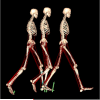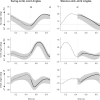Muscular coordination of knee motion during the terminal-swing phase of normal gait
- PMID: 17572431
- PMCID: PMC2795578
- DOI: 10.1016/j.jbiomech.2007.05.006
Muscular coordination of knee motion during the terminal-swing phase of normal gait
Abstract
Children with cerebral palsy often walk with diminished knee extension during the terminal-swing phase, resulting in a troublesome "crouched" posture at initial contact and a shortened stride. Treatment of this gait abnormality is challenging because the factors that extend the knee during normal walking are not well understood, and because the potential of individual muscles to limit terminal-swing knee extension is unknown. This study analyzed a series of three-dimensional, muscle-driven dynamic simulations to quantify the angular accelerations of the knee induced by muscles and other factors during swing. Simulations were generated that reproduced the measured gait dynamics and muscle excitation patterns of six typically developing children walking at self-selected speeds. The knee was accelerated toward extension in the simulations by velocity-related forces (i.e., Coriolis and centrifugal forces) and by a number of muscles, notably the vasti in mid-swing (passive), the hip extensors in terminal swing, and the stance-limb hip abductors, which accelerated the pelvis upward. Knee extension was slowed in terminal swing by the stance-limb hip flexors, which accelerated the pelvis backward. The hamstrings decelerated the forward motion of the swing-limb shank, but did not contribute substantially to angular motions of the knee. Based on these data, we hypothesize that the diminished knee extension in terminal swing exhibited by children with cerebral palsy may, in part, be caused by weak hip extensors or by impaired hip muscles on the stance limb that result in abnormal accelerations of the pelvis.
Figures












References
-
- Anderson FC, Goldberg SR, Pandy MG, Delp SL. Contributions of muscle forces and toe-off kinematics to peak knee flexion during the swing phase of normal gait: an induced position analysis. Journal of Biomechanics. 2004;37:731–737. - PubMed
-
- Anderson FC, Pandy MG. A dynamic optimization solution for vertical jumping in three dimensions. Computer Methods in Biomechanics and Biomedical Engineering. 1999;2:201–231. - PubMed
-
- Anderson FC, Pandy MG. Dynamic optimization of human walking. Journal of Biomechanical Engineering. 2001;123:381–390. - PubMed
-
- Anderson FC, Pandy MG. Individual muscle contributions to support in normal walking. Gait and Posture. 2003;17:159–169. - PubMed
-
- Arnold AS, Delp SL. Rotational moment arms of the medial hamstrings and adductors vary with femoral geometry and limb position: implications for the treatment of internally rotated gait. Journal of Biomechanics. 2001;34:437–447. - PubMed
Publication types
MeSH terms
Grants and funding
LinkOut - more resources
Full Text Sources

